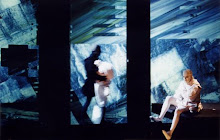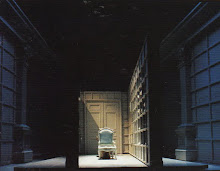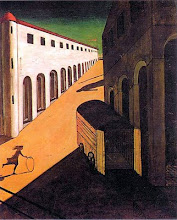Wednesday, 25 August 2010
Saturday, 21 August 2010
Friday, 6 August 2010
Friday, 23 July 2010
Tuesday, 20 July 2010
Tuesday, 1 June 2010
Creating virtual sets
It was considered to build the sets as physical models, film them and then edit the footage and add layers in After Effects, using camera tracking; this technique was already used in the development of the film in Part II but it proved to be problematic, in particular when trying to control the camera movement through the physical set. In order to allow more control over the sets and facilitate manoeuvre (i.e. camera movement), they will be build using two-dimensional components to create a 2.5 dimensional space in After Effects, therefore a virtual environment.
This video is a very basic test to try effects of light and duplicated layers in After Effects.
This video is a very basic test to try effects of light and duplicated layers in After Effects.
Developing the narrative of the film project
The departure of the story now is that of a subject creating his own reality as a means of escape from the collective reality of the contemporary city (this concept appears also in Part I). Following this idea, the structure of the narrative is divided in two parts, which are articulated through the element of the ‘temple’ (container of spatial system), differentiating between an outside and inside, between one reality and another. The first part is a collective urban reality (outside the ‘temple’) as an introduction representing the context-site interpretation; the second part is a synthetic reality projected by the subject (inside the ‘temple’) as a representation of mental space and time. The development of the narrative within the synthetic reality follows the analysis and mapping out of ‘Last year in Marienbad’, throughout the five sets (corridor, hall, room, gallery and garden).


Monday, 10 May 2010
Project 004_presenting the work


These sketches show how the main body of work would be presented. It consists of two parts: the model-container (which represents a place; fragments are visible only through peepholes; the sequence of static shots gives the idea of motion of the place contained in the film) and the film (which represents concrete space, creating a spatial sequence system; the place represented in the model-container is used as a ‘raw’ material).
Project 004_notes
Provisional title:
On representation
On interpretation
‘The foregoing story implies this: architecture, as distinct from building, is an interpretive, critical act. It has a linguistic condition different from the practical one of building. A building is interpreted when its rhetorical mechanism and principles are revealed. This analysis may be performed in a number of different ways, according to the forms of different types of discourse; among these are theory, criticism, history and manifesto. An act of interpretation is also present in the different modes of representational discourse: drawing, writing, model making and so on. Interpretation is also integral to the act of projecting.’ (Beatriz Colomina, 1988, Architectureproduction, p6)
Process:
Text/context (basis) > Interpretation (analysis and mapping out) > Representation (various media)
Text/context starting point:
- Narrative, storytelling text: from ‘Last year in Marienbad’
- Cultural, geographical, socio-political context (in relation to the text of ‘Last year in Marienbad’; concepts from the text are translated to concepts that refer to the context described; i.e. Ambiguity, uncertainty, repetition, time-space continuum, sense of no-place): from western society, late-capitalism (new economies impact on urban events), contemporary city (London) > Introduction of a reflection on the contemporary metropolis in relation to the subject. > Chosen site (TBC): east London, suburbia, areas with sense of no-place, homeless character. > Document
On representation
On interpretation
‘The foregoing story implies this: architecture, as distinct from building, is an interpretive, critical act. It has a linguistic condition different from the practical one of building. A building is interpreted when its rhetorical mechanism and principles are revealed. This analysis may be performed in a number of different ways, according to the forms of different types of discourse; among these are theory, criticism, history and manifesto. An act of interpretation is also present in the different modes of representational discourse: drawing, writing, model making and so on. Interpretation is also integral to the act of projecting.’ (Beatriz Colomina, 1988, Architectureproduction, p6)
Process:
Text/context (basis) > Interpretation (analysis and mapping out) > Representation (various media)
Text/context starting point:
- Narrative, storytelling text: from ‘Last year in Marienbad’
- Cultural, geographical, socio-political context (in relation to the text of ‘Last year in Marienbad’; concepts from the text are translated to concepts that refer to the context described; i.e. Ambiguity, uncertainty, repetition, time-space continuum, sense of no-place): from western society, late-capitalism (new economies impact on urban events), contemporary city (London) > Introduction of a reflection on the contemporary metropolis in relation to the subject. > Chosen site (TBC): east London, suburbia, areas with sense of no-place, homeless character. > Document
Wednesday, 7 April 2010
Project 003_suite number one
This film project is part of the work build up during the second term of the course, which will be developed during the next term.
Tactics, methodologies, used in film and theatre have informed me to start the development of new tactics in architecture, and also to create a dialog between the three disciplines in order to propose a system of potential outcomes.
The project explores tactics found in theatre through the use of the moving image; the intention is to go beyond the limitations of the physical theatre space, creating a virtual space framed by a system.
The search is directed towards the construction of meaning through architecture possibilities, using tactics like montage, and the relationship between self and other, presence and absence, movement and gesture, and looking at how this representations operate together within a film.
As a starting point for the analysis and mapping of scenes I decided to take the Ciné- Novel Last Year in Marienbad by Alain Robbe-Grillet (which it was written as a script, describing the film shot by shot) and the consequent film of the same title by Alain Resnais.
The camera acts as a driver not only to explore the apparent inaccessible architectural space but also to augment the space (travelling from scene to scene). The camera is the spectator in the film (which is the main character) and explores and reveals the spaces that wouldn’t be shown to the external audience from the ‘stage’ space only (where the performers act); it is not used as a recording device only. The audience perceives the (cinematic) space through the spectator in the film, which perceives this (performance) space at the same time. A relationship between audience, spectator (camera) and performer in the space represented is established. (00:01:13; low resolution)
Tactics, methodologies, used in film and theatre have informed me to start the development of new tactics in architecture, and also to create a dialog between the three disciplines in order to propose a system of potential outcomes.
The project explores tactics found in theatre through the use of the moving image; the intention is to go beyond the limitations of the physical theatre space, creating a virtual space framed by a system.
The search is directed towards the construction of meaning through architecture possibilities, using tactics like montage, and the relationship between self and other, presence and absence, movement and gesture, and looking at how this representations operate together within a film.
As a starting point for the analysis and mapping of scenes I decided to take the Ciné- Novel Last Year in Marienbad by Alain Robbe-Grillet (which it was written as a script, describing the film shot by shot) and the consequent film of the same title by Alain Resnais.
The camera acts as a driver not only to explore the apparent inaccessible architectural space but also to augment the space (travelling from scene to scene). The camera is the spectator in the film (which is the main character) and explores and reveals the spaces that wouldn’t be shown to the external audience from the ‘stage’ space only (where the performers act); it is not used as a recording device only. The audience perceives the (cinematic) space through the spectator in the film, which perceives this (performance) space at the same time. A relationship between audience, spectator (camera) and performer in the space represented is established. (00:01:13; low resolution)
Friday, 5 February 2010
Test for Project 003
This is a very basic test using still images in After-Effects in a 3D space; some of the images have been distorted to create a false perspective, which is revealed through the camera movement. Note: the use of these particular images from a group of industrial buildings is only chosen to test the technique; there is no intention to use them in the film. (00:00:10)
Andrea Palladio, Proscenium of the Teatro Olimpico, Vicenza, Italy, 1584



Instead of painting the design on canvas, as usually done for theatre props, Palladio designed the stage built of wood and plaster, using spatial techniques to manipulate and exaggerate the perspective. The section helps to understand how it is done.A similar technique will be used in the form of moving image, where only the movement through the space will reveal the montage.
Idea for Project 003 (title to be defined)
WHAT
- Each subject hides a story; urban spaces are loaded with stories.
- Each subject hides a story; urban spaces are loaded with stories.
- Spaces of transition or non-places in an urban environment are anonymous; they are used and then abandoned.
- The non-place holds multiple narratives but also reflects social interaction and alienation experienced in these sorts of contemporary urban spaces.
- Imagine hidden stories and relationships that are part of an urban and social space (stories that we find in non-places) and represent them in the form of a theatrical set.
- The theatrical set holds fictional realities; in this space the subjects project an image of their otherness.
- Non-place: representation of movement and gesture; noise; presence; self.Stage space: stasis; controlled sound; absence; other.
HOW
- Find a non-place (i.e. train station) and abstract, suggest a narrative to be represented as an example.
- Find a non-place (i.e. train station) and abstract, suggest a narrative to be represented as an example.
- The starting point to set the narrative and the characters is the film ‘Last year in Marienbad’ by Alain Resnais. This is chosen because, through its apparent simple plot, it is enigmatic and baffles the viewer. The figures that appear in it ‘are trapped (…) in a world limited in space and time, which seems to begin again and again’ (Lagier, in documentary about the film).

- The narrative starts from the non-place and is projected onto the theatre set, where it is represented.
- The stage space is composed by series of theatre props in the form of successive images in different layers, to achieve depth of field. These props move, stretch, connect one scene to the next, augmenting architectural space.
- The characters within the stage are cut off from any context, they appear static-maybe (test).
- The stage set is described as a labyrinth; the motif of the labyrinth, as in the film referenced, is present throughout the setting.
- Within the stage space, the camera acts as an external character and audience simultaneously.
- Play with rhythm in the film i.e. obsessive repetitions, changes of speed, temporal clashes.
- For the stage set use false and exaggerated perspective. The first shot is static (it shows the ‘correct’ perspective); only when the camera moves through the space the montage is revealed.
Note regarding Project 003
There has been an evolution from the first idea (which dealt with the space of the subject using a membrane as an element to represent the body interlinking with its outside and inside) to the next one, which I find it to be more exciting and it has more possibilities in order to develop a set of tactics and themes beyond the master course. This idea is explained in the next post.
Monday, 1 February 2010
Drawing Restraint, Matthew Barney

In Drawing Restraint series, Matthew Barney uses physical obstacles and tools to complicate the process in an attempt to draw a graphic mark in an architectural space. The images produced indicate the energy used to make them and the representation of a mark. The subject uses the architectural space, takes something from it and gives something back to it, adds a mark into the space; in a way the subject appropriates and transforms the architectural space.
Dance with Camera

Bojangles of Harlem (1936)
These two films are part of the Dance with Camera programme http://www.ubuweb.com/film/dance-with-camera.html
In Bojangles of Harlem (1936), Fred Astaire dances along with projected images of himself in the form of shadows; there are punctual interactions between the images and him. The use of the replicated images and their change of scale add dynamism to the performance; in a way the self appears dancing with his others.
In Danse Serpentine (1896) by The Lumière Brothers, the dancer performs with a voluptuous dress where coloured lights are projected. The performance acquires a particular an attractive dynamism using simple gestures.
In Bojangles of Harlem (1936), Fred Astaire dances along with projected images of himself in the form of shadows; there are punctual interactions between the images and him. The use of the replicated images and their change of scale add dynamism to the performance; in a way the self appears dancing with his others.
In Danse Serpentine (1896) by The Lumière Brothers, the dancer performs with a voluptuous dress where coloured lights are projected. The performance acquires a particular an attractive dynamism using simple gestures.
Membrane tests
Test to visualize the membrane element described previously, using a translucent balloon filled with water, to represent fluidity. (00:00:55; low resolution)
Test to explore the plasticity and elasticity of the membrane, using the same technique than before and the hand to manipulate the balloon. (00:00:32; low resolution)
Monday, 18 January 2010
Idea for Project 003

This sketch is trying to communicate the complex idea of the body interlinking with its outside and inside (understanding these concepts as I explained in ‘Notes for Project 003’) and its relation to other bodies. It represents bodies within a membrane that covers the body externally and internally; each surface of this membrane gets infected and receives impulses from both, the outside and the inside; one affects the other. This project proposes an exploration of the outside and the inside by travelling through the bodies using the membrane as the element that links them together and by building up a chain of subjects. In the sketch there are some particles that escape from the inside to the outside or the other way around. It could happen that the membranes gradually blur as we move forward through the chain.
Notes for Project 003_What I am interested in
How do we interpret the space of the subject? We could define the body (subject) as a boundary between an outside (space) and an inside (space); for now I would refer to the outside as real space and the inside as imaginary space, although this may change. How the subject, the outside and the inside interlink? What happens when the boundary merges, blurs, multiplies? What if the subject fuses with the space? Within the social field subjects relate to each other; different subjectivities have different spaces; if we can say that subjects share an outside space, is there an inside space a group of subjects can share as well?
My intention is not to propose an enclosed model, but a framework for the space of the subject or group of subjects, and to represent this.
When I mention the space of the subject here I don’t refer particularly to the space that has to do with sorts of behaviours socially and culturally formed; I refer to the spaces that we perceive, read, explore, experience, practice, represent, draw, imagine: particularly the architectural space and imaginary space in a socio-cultural context; “…evidence of its [space] existence stares us in the face: our senses and our thoughts apprehend nothing else. “ (Henri Lefebvre, The Production of Space: 12)
My intention is not to propose an enclosed model, but a framework for the space of the subject or group of subjects, and to represent this.
When I mention the space of the subject here I don’t refer particularly to the space that has to do with sorts of behaviours socially and culturally formed; I refer to the spaces that we perceive, read, explore, experience, practice, represent, draw, imagine: particularly the architectural space and imaginary space in a socio-cultural context; “…evidence of its [space] existence stares us in the face: our senses and our thoughts apprehend nothing else. “ (Henri Lefebvre, The Production of Space: 12)
Friday, 15 January 2010
John Cage's HPSCHD at Macba
This video was recorded in the John Cage's exhibition at Macba. It is one of the installations featured in the exhibition; HPSCHD. I have posted it as a reminder of the pleasure experienced in that room.
"HPSCHD, a collaboration between John Cage and Lejaren Hiller, first performed on May 16, 1969 at the University of Illinois at Urbana-Champaign, called for 7 harpsichords playing randomly-processed music by Mozart and other composers, 51 tapes of computer-generated sounds, approximately 5,000 slides of abstract designs and space exploration, and several films, all of which were performed or presented simultaneously in an asynchronous and exuberant anarchy of activity."
http://www.macba.es/controller.php?p_action=show_page&pagina_id=34&inst_id=25201
"HPSCHD, a collaboration between John Cage and Lejaren Hiller, first performed on May 16, 1969 at the University of Illinois at Urbana-Champaign, called for 7 harpsichords playing randomly-processed music by Mozart and other composers, 51 tapes of computer-generated sounds, approximately 5,000 slides of abstract designs and space exploration, and several films, all of which were performed or presented simultaneously in an asynchronous and exuberant anarchy of activity."
http://www.macba.es/controller.php?p_action=show_page&pagina_id=34&inst_id=25201
Subscribe to:
Comments (Atom)






















